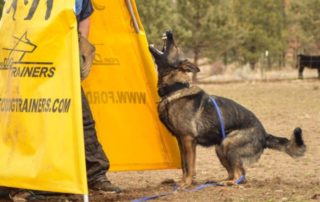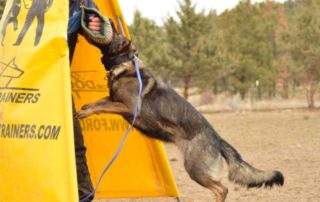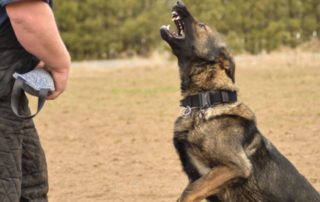
Welcome to Bite Club
We train with High Desert Schutzhund Club and strive to provide a safe, fun and welcoming learning enviroment for you and your dog. We are a like minded group of people that just enjoy working with dogs, while working as a group to add valuable feedback and input to help you reach your training goals. Whether you competed in Schutzhund, are new to the sport, or just want polish up your handling & obedience, we welcome you and your dog.
What is Schutzhund/IPO?
Schutzhund or IPO is a dog sport originating in Germany and was the original test used for German Shepherds to prove their breed worthiness. It is still used for this purpose to this day. Schutzhund is a three phase sport including Tracking, Obedience and Protection. Each dog must score a minumim number of points to proceed to the next phase and complete all three phases to earn each respective title.
The BH or companion dog title is a pre-requirement for IPO titles. All breeds and sizes are eligible with the minimum age requirements of 15 months.
There are three levels of the IPO test:
IPO 1, IPO 2, IPO 3
In addition to the IPO titles listed above, the United Schutzhund Clubs of America offers several other training degrees: the STPr, FH 1, FH 2, and IPO-FH tracking degrees; the AD which is an 12.5 mile endurance test (one of the requirements for the Breed Survey); separate obedience, protection and tracking titles that reflect the routines for IPO 1, 2, & 3 levels; and RH titles.
For IPO 1 the dog must be at least 18 months old and pass an initial temperament test by the judge. In tracking, it must be able to follow a track laid by its handler at least 20 minutes earlier. In obedience, the dog must heel off leash, demonstrate the walking sit, the walking down, and the long down under distraction, as well as the send-out. It must retrieve on the flat and over a hurdle, and over the scaling wall. In the protection phase, the dog must search 2 blinds, perform escape and courage test exercises, and demonstrate a side transport.
For IPO 2 the dog must be at least 19 months old and must already have earned its IPO 1 degree. In tracking, the IPO 2 candidate must be able to follow a track laid by a stranger at least 30 minutes earlier.
It must again pass all of the obedience and protection tests required for the IPO 1 degree, but those tests, for IPO 2, are made more difficult and require greater endurance, agility, and, above all, control. There is an additional walking stand exercise required in obedience. In protection, the dog must search 4 blinds and demonstrate a back transport of the decoy in addition to the IPO exercises.
For IPO 3, the dog must be at least 20 months old and must have earned both the IPO 1 and the IPO 2 titles. Again, the tests now are made far more difficult. The track has four turns, compared with two turns for IPO 1 and 2, and there are three objects, rather than two, that must be found by the dog. The track must be laid by a stranger and be at least 60 minutes old. All exercises in obedience and protection are demonstrated off leash. The walking stand is replaced by the running stand. The picture of obedience, strength, eagerness, and confidence presented by an excellent IPO 3 team is a beautiful illustration of the partnership of human and dog.
Tracking
At all levels, a track is laid earlier by a person walking normally on a natural surface such as dirt or grass. For IPO 1 titles, the track is laid by the handler. For IPO 2 or 3 tracking titles, the track is laid by a stranger. The track includes a number of turns and a number of small, man made objects left by this person on the track itself. At the end of a 10 meter leash, the handler follows the dog, which is expected to scent the track and indicate the location of the objects, usually by lying down with it between its front paws. The tracking phase is intended to test the dog’s trainability and ability to scent, as well as its mental and physical endurance.

Obedience
The obedience phase includes a series of heeling exercises, some of which are closely in and around a group of people. During the heeling, there is a gun shot test to assure that the dog does not openly react to such sharp noises. There is also a series of field exercises in which the dog is commanded to sit, lie down, and stand while the handler continues to move. From these various positions, the dog is recalled to the handler. With dumbbells of various weights, the dog is required to retrieve on a flat surface, over a one-meter hurdle, and over a six-foot slanted wall. The dog is also asked to run in a straight direction from its handler on command and lie down on a second command. Finally, each dog is expected to stay in a lying down position away from its handler, despite distractions, at the other end of the obedience field, while another dog completes the above exercises. All of the obedience exercises are tests of the dog’s temperament, structural efficiencies, and, very importantly, its willingness to serve its owner.
Protection
The protection phase tests the dog’s courage, physical strength, and agility. The handler’s control of the dog is absolutely essential. The exercises include a search of hiding places, finding a hidden person (acting as a decoy), and guarding that decoy while the handler approaches. The dog is expected to pursue the decoy when an escape is attempted and to hold the grip firmly. The decoy is transported to the judge with the handler and dog walking behind and later at the decoy’s right side. When the decoy attempts to attack the handler, the dog is expected to stop the attack with a firm grip and no hesitation. The final test of courage occurs when the decoy is asked to come out of a hiding place by the dog’s handler from the opposite end of the trial field. The dog is sent after the decoy who is threatening the dog with a stick and charging at the handler. All grips during the protection phase are expected to be firmly placed on the padded sleeve and stopped on command and/or when the decoy discontinues the fight. The protection tests are intended to assure that the dog possesses the proper temperament for breeding.




